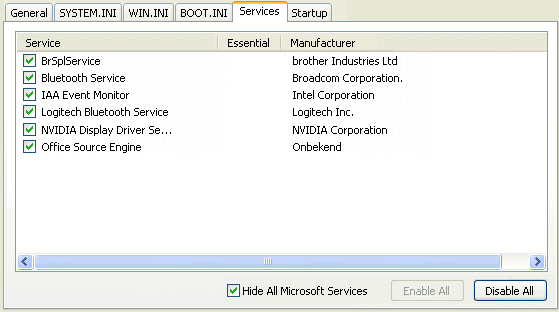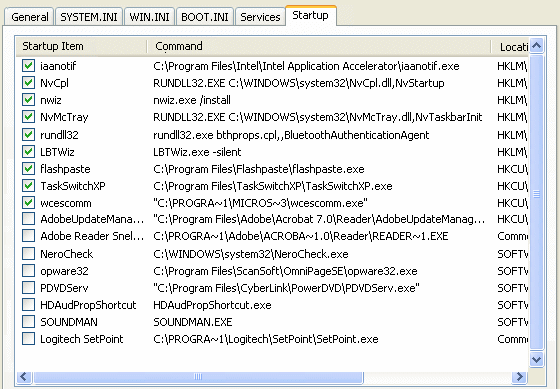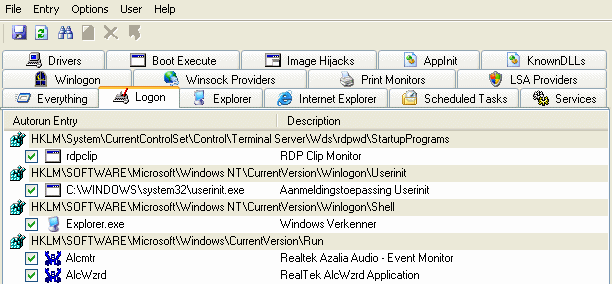
Many computers are 'infected' with unwanted software which in most cases are hard to remove as well. This can be a virus or preinstalled software by the vendor. However, in most cases it is not that difficult to remove the unwanted software. This page describes in brought lines how to remove those software, with a faster and more user friendly computer as a result.
There is multiple reasons to disable or remove software: it improves the time to startup, unwanted software, pop-ups, a slow computer, a slow internet connection, e.a. It happens frequently that software is installed (by accident or deliberately...) which results in unexpected problems (like irritating pop-ups from adware). Especially new computers are frequently shipped with lots of unwanted software.
The best way to uninstall software is to do it the normal way by the option Software (XP)/Programs and Features (Vista) in the Control Panel. Sometimes there is a shortcut to the uninstall file in the program group of the Start Menu. This shortcut can also be used for uninstalling the software. The tool MyUninstaller (download: www.nirsoft.net/utils/myuninst.html) is a good alternative. Becasue the Advanced Mode (via View in the menu bar) alows to select multiple uninstallers at once, this tool works faster.
Search for uninstall files in the folder C:\Program Files
If there is no uninstall shortcut (anymore), the uninstall tool can
sometimes be found in the program folder under
C:\Program
Files. Search for a file with the name UNINSTALL.EXE (in most
cases the icon of a recycle bin is added), and in some cases the setup file
(SETUP.EXE) can uninstall the software as well.
ATTENTION: Contrary what some people think, a program is not uninstalled by deleting the shortcut from the program group in the Start Menu or by deleting the files in the program folder from the folder Program Files! This is not the right way because it will not remove the registry keys and registry values!
|
|
What if the uninstall procedure is not working...
If if is no longer possible to uninstall the software the normal way,
sometimes it helps to reinstall the software to make sure all files are
where they should be. There is a chance this will repair the uninstall
procedure as well. Of course, this reinstalling is only possible when the
original installation files are still available. Reason enough to save the
downloaded installation files on a safe location, you never know whether they
will be useful later on!
Sometimes it is useful to let a program start automatically with Windows, but for many applications this is not desirable. Many auto starting applications place a shortcut in the system tray (which makes it obvious that the application is running automatically), but this is not always the case.
The problem of all these started programs, is the longer time to boot Windows and the use of system resources which are no longer available for other applications. When these applications are not used at all, it is better to disable them at startup and to manually start them whenever needed.
Speed up the computer by disabling software
Disabling the applications which are not frequently used will improve the
system performance remarkably. Most applications offer this option at setup,
if you are not sure it is better to disable this option. This option is also
offered in the settings of many programs, like the following example of
Flashpaste (www.download.com,
one of the few applications which is very useful to boot at startup).

If there is no uninstall procedure, the automatic startup can be disabled with the Windows tool MSCONFIG as well. This tool offers an overview of the automatically started programs and services when Windows is started (to start this too, enter the command MSCONFIG in the run/search field of the Start Menu). When you start this program, you will be surprised how many automatic startup items there really are, without knowing about it! Most of them you probably don't even recognize! Don't get confused when you don't understand all entries, even an expert needs a closer look at some of the applications to find what they are used for...
The shown services are started before the startup items. Most of them belong to Windows and it is wise to keep them untouched. But some of them are added by installed software, most of them can safely be disabled. Those non Windows services are shown on the tab Services while the option Hide all Microsoft services is enabled. After hiding the Microsoft services, MSCONFIG only shows the services added by other programs.
ATTENTION: Actually, the sub Services (available by the Control Panel, sub Administrative Tools) is the best and only place to make changes to the Windows services. When essential services are disabled with MSCONFIG, there is a chance that Windows no longer boots! For more information visit the page about disabling Windows services,

On many computers you will find a long list of services from different software vendors/manufacturers. Because the names of the services are not always that obvious, the name of the vendor/manufacturer will give an indication what the service is used for. After combining the information of the service, the manufacturer and the history of the computer are combined, it will probably give a clue.
Disable all items you don't need or don't trust
Disable all the services which you don't need or don't trust (e.g. a
possible virus). This can be done safely, but remember it can be the cause
of error messages or programs which no longer operate as they should do. If
there is a problem, just enable the service and the problems should be
solved after a restart of Windows. If it is not clear which disabled service
caused the problem, use a 'trial and error' method to find it. If some time
elapses, it becomes hard to trace the cause, so don't forget you have made
changes to the services! If needed, make some notes of the disabled
services.
The tab Startup shows the application to start when the services are loaded. Most of the applications mentioned here are probably not needed at all. Fortunately, based on the name, the manufacturer and the command it is for many items clear what they are used for. Just disable the applications which are rarely or never used.
Disable the items you don't need
All items which are used for checking for program updates, are in most
cases not necessary. The entries which prestart programs (like Adobe Reader
and
Microsoft Office), can be disabled safely. Disable the applications which
are rarely or not used as well, they can be started manually as well. When
the system misses some functionality, they can be enabled any time.
In the example below many entries are disabled, like AdobeUpdateManager, Adobe Reader Snelstart, NeroCheck, Opware32 (for scanning), PowerDVD, audio software (not needed in this configuration) and Logitech SetPoint (does not function properly any way in this configuration).

In the example, only the necessary items have been left over like the Application Accelerator from Intel, the NVIDIA features (graphics card), Bluetooth support and usefull additional tools like TaskSwitchXP and FlashPaste. The item wcescomm.exe appears to be from the application Microsoft ActiveSync, the synchronization software for a PDA/MDA.
Combine the information of MSCONFIG with the information from the firewall
Although it is not always clear what the entries are used for, a firewall (like
Comodo
Firewall) can be of use, especially when this application is trying to
access the internet. By combining the MSCONFIG information with the
information from the firewall, will probably give a good idea, especially if
a virus uses the whole bandwidth of the internet connection (disabling a
virus has to be done in Safe Mode (press F8 at Windows startup) to
disable the virus). In the example
above, the firewall was useful to identify
WCESCOMM.EXE
as the synchronization tool
Microsoft ActiveSync.
TIP: If you have no idea what a program is used for, you can still search the internet. There are multiple websites with information about processes, like www.processlibrary.com. The information on those websites will give a good idea whether a process is usefull or not.
Tracing the running processes with the Windows Task Manager
The key combination CTRL-SHIFT-ESC
opens Windows Task Manager
(available by right clicking the menu bar as well). The first tab
Applications shows a list
of the started applications. The second tab
Processes is actually
more interesting because it gives a overview of all running processes (applications
and services included). By clicking the column title CPU, the most active
processes will be placed on top.
This build in tool does not show a lot of information of the running processes and the accompanying files. The alternative tool Process Explorer (download: www.microsoft.com/technet/sysinternals/ProcessesAndThreads/ProcessExplorer.mspx) however, gives a lot more information. By Process, Properties it is very easy to find the file location of a specific process. This makes it a lot easier to trace the actual name of the application which will indicate whether it is a wanted or unwanted application. The next step is to disable it with MSCONFIG.
If a security suite is installed, there will be multiple entries on both the Service tab and the Startup tab, which are recognized easily by their name. Most of those security suites consume a lot of system recourses, disabling them will improve system performance significantly! Especially for older computers, it is not wise to install one of those suites. If you did, try to disable the services and startup items of the security suite, and experience the difference after a restart of Windows.
ATTENTION: Security software is not always easy to disable: in some cases this has to be done in Safe Mode (press F8 at the startup of Windows).
The security suite becomes active again by enabling the disabled items in MSCONFIG and to reboot the computer. Permanently removing the security suite is done by the sub Software (XP) / Programs and Features (Vista) in the Control Panel.
Alternative free security software consumes less system resources
Fortunately, there is free security software available which consume less
system resources compared to the commercial security suits. For example,
there are free antivirus
software (like AVG Virus scan
software) and free
firewall software (like
Comodo
Personal Firewall).
In many cases, disabling a virus or popup window is easier then you would expect, especially if you are following a straight forward procedure. Start MSCONFIG, disable all NOT Microsoft services on the tab Services and disable all items on the tab Startup. Before making any changes, make some notes which services and startup items have been disabled already in a previous session! Reboot the computer and check the two tabs in MSCONFIG whether one of the items has been enabled again. This might be a virus because they are hard to disable (just like security software). In this case, the virus has to be disabled after booting the computer in Safe Mode (press F8 at startup of Windows). After a reboot of Windows start MSCONFIG to verify whether the virus has not been activated again. If everything is fine, all desired items on the tabs Services and Startup can be enabled again.
Delete the files as well
Disabling the items won't delete the activated files from the hard disk. In
the next step, the files can (but it is not necessary) be deleted with the Windows
Explorer (don't forget to enable the options to show the hidden and system
files (Tools,
Folder Options,
tab View). For most entries, MSCONFIG shows the exact location
of these files.
Are there still pop-ups or a changing home page? If the cause of the problems is not clear, try to reset the Internet Explorer to its default settings (this is done by Tools, Internet Options, tab Advanced, button Reset). Most problems are solved by this resetting of the Internet Explorer. The only disadvantage is the resetting of the personal settings as well, like the changing of the default home page. As an alternative, deactivate the loaded add-ons by Tools, Internet Options, tab Programs, button Manage add-ons. The list will probably be quite long and difficult to survey, but only the enabled add-ons are important. Change the combo box Show to only show the currently loaded add-ons. Select the unwanted add-on(s) and disable it, as shown in the example.

When typing in a website address, it is still possible to land on a different webpage (for example the webpage for telebanking which looks the same as the original) without knowing it, because of an unknown change of the HOSTS file by viruses. Some viruses change the HOSTS file, to forward requests for a certain website to a different web server. See this website for more information about editing the HOSTS file.
The tool AutoRuns from Sysinternals (download: www.microsoft.com/technet/sysinternals/ProcessesAndThreads/Autoruns.mspx) gives a better overview of the items which startup with Windows and has possibilities to disable them. Especially the tabs Logon and Internet Explorer are interesting.
Be careful with this tool. Only disable the items of which you are sure they are not important for the functioning of Windows. If the wrong items are disabled (accidently), it is possible Windows won't boot anymore! Only when a backup of the system (image) is available, it is safe to try all options.
If you are not sure, it is better not to change the items with the Publisher name Microsoft Corporation. To hide those items use Options, Hide Microsoft Entries. Press F5 or restart Autoruns to refresh the window. This limits the risk of disabling essential.

TIP: The other user accounts can be edited as well by User in the menu bar!
By double clicking the item, the specific location where it is stored is opened. This can be a folder or somewhere in the registry. All important information is shown by right clicking an item, option Properties. If this is not enough, a Google search for the item is possible as well. This makes Autoruns a very powerful tool for solving startup problems.
© 2001-2022 - Menno Schoone - SchoonePC - Rotterdam - The Netherlands